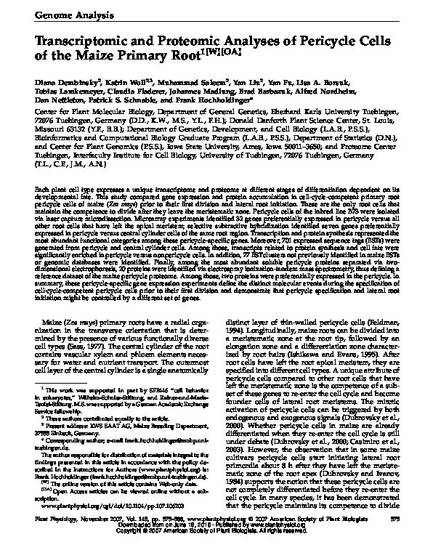
Each plant cell type expresses a unique transcriptome and proteome at different stages of differentiation dependent on its developmental fate. This study compared gene expression and protein accumulation in cell-cycle-competent primary root pericycle cells of maize (Zea mays) prior to their first division and lateral root initiation. These are the only root cells that maintain the competence to divide after they leave the meristematic zone. Pericycle cells of the inbred line B73 were isolated via laser capture microdissection. Microarray experiments identified 32 genes preferentially expressed in pericycle versus all other root cells that have left the apical meristem; selective subtractive hybridization identified seven genes preferentially expressed in pericycle versus central cylinder cells of the same root region. Transcription and protein synthesis represented the most abundant functional categories among these pericycle-specific genes. Moreover, 701 expressed sequence tags (ESTs) were generated from pericycle and central cylinder cells. Among those, transcripts related to protein synthesis and cell fate were significantly enriched in pericycle versus nonpericycle cells. In addition, 77 EST clusters not previously identified in maize ESTs or genomic databases were identified. Finally, among the most abundant soluble pericycle proteins separated via two-dimensional electrophoresis, 20 proteins were identified via electrospray ionization-tandem mass spectrometry, thus defining a reference dataset of the maize pericycle proteome. Among those, two proteins were preferentially expressed in the pericycle. In summary, these pericycle-specific gene expression experiments define the distinct molecular events during the specification of cell-cycle-competent pericycle cells prior to their first division and demonstrate that pericycle specification and lateral root initiation might be controlled by a different set of genes.
Available at: http://works.bepress.com/dan-nettleton/106/

This article is published as Dembinsky, Diana, Katrin Woll, Muhammad Saleem, Yan Liu, Yan Fu, Lisa A. Borsuk, Tobias Lamkemeyer et al. "Transcriptomic and proteomic analyses of pericycle cells of the maize primary root." Plant physiology 145, no. 3 (2007): 575-588. doi: 10.1104/pp.107.106203. Posted with permission.